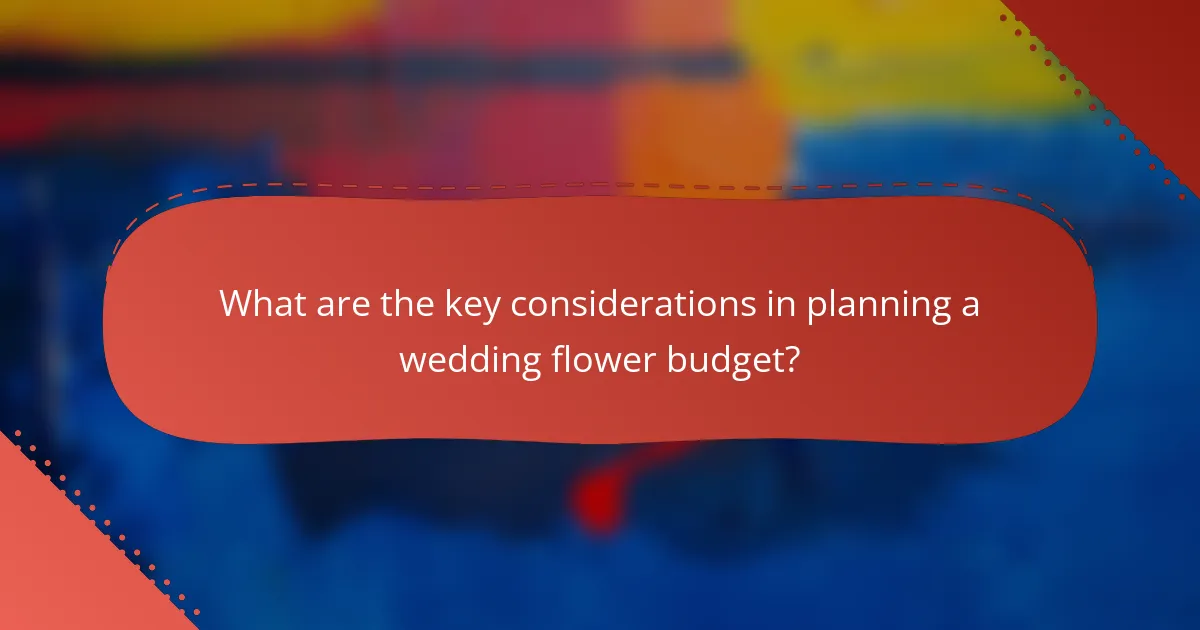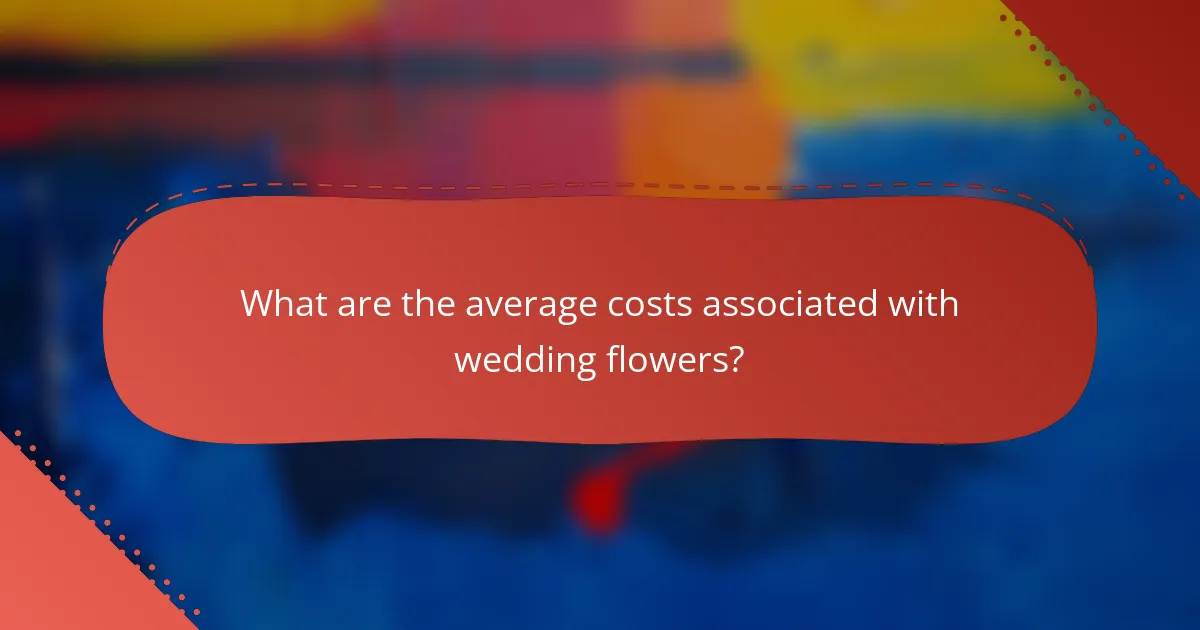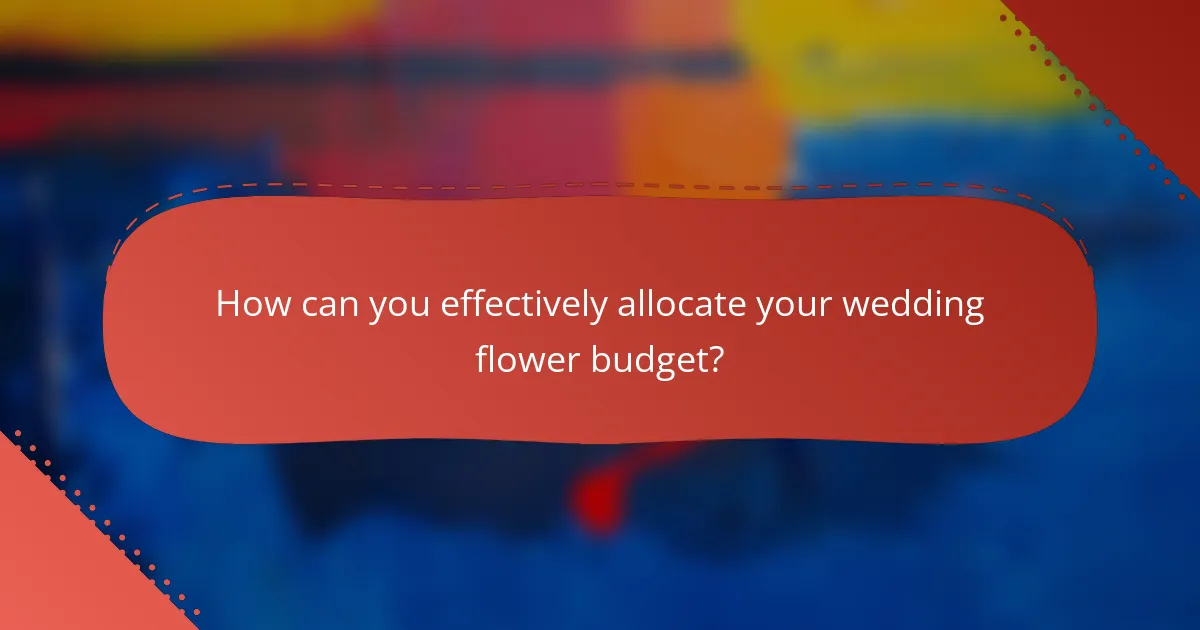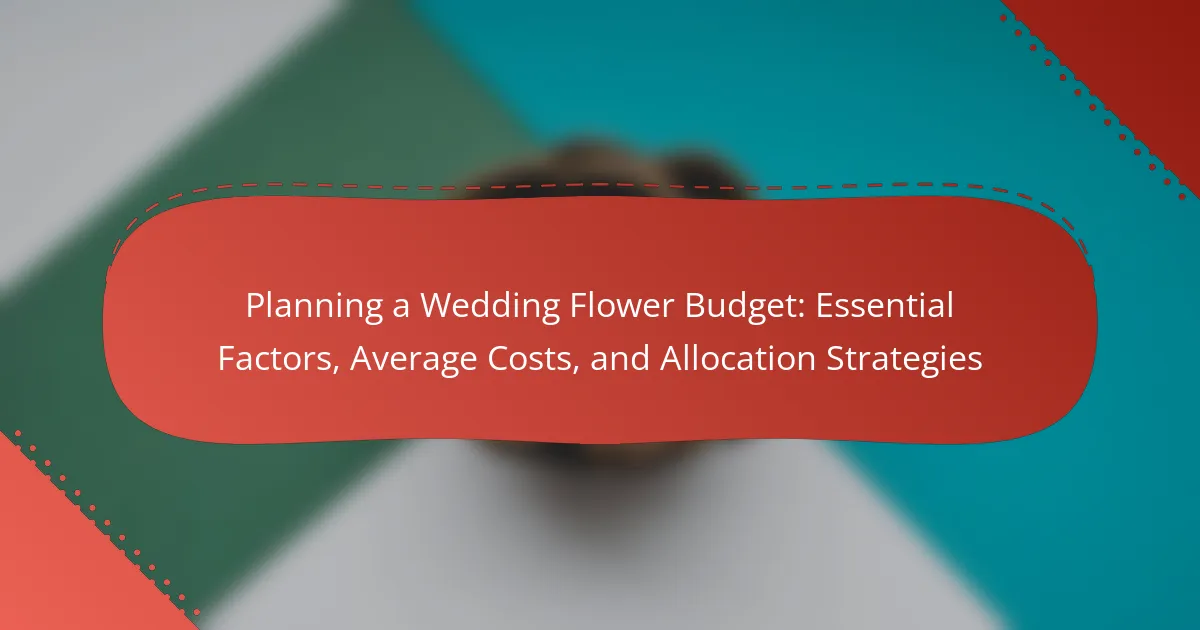
What are the key considerations in planning a wedding flower budget?
The key considerations in planning a wedding flower budget include determining the overall budget, selecting flower types, and understanding seasonal availability. Establishing a clear budget helps prioritize spending. Different flowers have varying costs. For instance, exotic flowers typically cost more than local blooms. Seasonal flowers are often more affordable and fresher. Additionally, consider the number of arrangements needed. Bouquets, centerpieces, and ceremony decorations all contribute to the total. Labor costs for arrangement and delivery should also be factored in. Finally, it’s essential to account for additional expenses like vases and transportation. These considerations ensure a well-rounded and realistic flower budget.
How do seasonal flowers impact the wedding flower budget?
Seasonal flowers can significantly reduce the wedding flower budget. They are typically more abundant and easier to source during their peak growing seasons. This abundance often leads to lower prices compared to out-of-season flowers, which may require special ordering or shipping. For example, peonies are less expensive in spring when they are in season, while they can cost much more in winter. Additionally, using seasonal flowers allows couples to allocate more budget to other areas of their wedding, such as venue or catering. Overall, choosing seasonal flowers is a cost-effective strategy for managing the wedding flower budget.
What are the benefits of choosing seasonal flowers for your wedding?
Choosing seasonal flowers for your wedding offers numerous benefits. Seasonal flowers are typically more affordable due to their abundance. They are easier to source and often require less transportation, reducing costs. Freshness is another advantage; seasonal blooms are harvested at their peak, ensuring vibrant colors and longer-lasting arrangements.
Additionally, seasonal flowers are more environmentally friendly. They require less energy for growth and transportation, supporting local agriculture. The variety of options available during each season allows for creative and diverse floral designs.
Finally, using seasonal flowers can enhance the overall theme and aesthetic of your wedding, creating a cohesive and natural look that resonates with the time of year.
How can you determine which flowers are in season for your wedding date?
To determine which flowers are in season for your wedding date, consult a seasonal flower guide. These guides list flowers by month and region. You can find them in gardening books or online resources. Local florists also provide insights on seasonal blooms. They have experience with flowers that thrive in your area. Additionally, consider your wedding date and location. Different climates affect flower availability. For example, spring flowers vary from those in winter. Researching these factors ensures you select flowers that are fresh and affordable.
Why is it important to set a wedding flower budget early?
Setting a wedding flower budget early is crucial for effective planning. It helps couples prioritize their floral needs and allocate funds appropriately. An early budget enables informed decisions about flower types and arrangements. This approach prevents overspending and allows for adjustments if necessary. According to The Knot, the average couple spends about $2,000 on wedding flowers. Establishing a budget early ensures that couples stay within this average or adjust their expectations accordingly. Early budgeting also facilitates discussions with florists and helps secure the desired flowers in advance.
What are the potential consequences of not having a budget for wedding flowers?
Not having a budget for wedding flowers can lead to overspending and financial strain. Without a defined budget, couples may choose extravagant floral arrangements that exceed their financial capacity. This often results in unexpected costs that can disrupt the overall wedding budget. Additionally, a lack of budgeting can lead to poor decision-making regarding flower selection and vendor choice. Couples may feel pressured to make last-minute changes that can further inflate costs. According to The Knot, the average couple spends about $2,000 on wedding flowers, highlighting the importance of budgeting to avoid financial pitfalls. Ultimately, not having a budget can create stress and diminish the joy of planning a wedding.
How can early budgeting help in negotiating with florists?
Early budgeting helps in negotiating with florists by establishing a clear financial framework. This framework enables couples to communicate their budget constraints effectively. When florists understand the budget, they can suggest appropriate floral arrangements. Early budgeting also allows for comparison shopping among different florists. This comparison can lead to better pricing and value for services. Additionally, having a budget can help prioritize essential flowers over luxury options. According to a survey by The Knot, couples who budget early save an average of 15% on floral costs. Thus, early budgeting is a strategic tool in wedding planning that enhances negotiation power.
What factors influence the overall cost of wedding flowers?
The overall cost of wedding flowers is influenced by several factors. Flower types significantly impact pricing. Premium flowers like peonies and orchids are more expensive than standard blooms. Seasonal availability also plays a role; flowers in season are generally cheaper. The size and complexity of arrangements affect costs as well; larger or intricate designs require more materials and labor. Venue location can influence prices due to local market rates and transportation costs. Additionally, the florist’s experience and reputation can lead to varying pricing structures. Finally, quantity needed for bouquets, centerpieces, and decorations directly affects the total cost.
How do flower types and arrangements affect pricing?
Flower types and arrangements significantly affect pricing. Different flower varieties have varying costs based on availability and demand. Premium flowers like peonies or orchids are typically more expensive than common blooms like daisies or carnations. Additionally, seasonal flowers are often cheaper when in bloom, while out-of-season flowers can incur higher prices due to shipping and sourcing challenges.
The arrangement style also influences the overall cost. Complex designs, such as cascading bouquets or elaborate centerpieces, require more time and skill, leading to higher labor costs. Simple arrangements, on the other hand, are generally more affordable.
According to a survey by The Knot, floral costs can range from 8% to 10% of a wedding budget, depending on the chosen flowers and arrangements. This highlights the importance of selecting flowers that fit both aesthetic desires and budget constraints.
What role does the venue play in determining flower costs?
The venue significantly influences flower costs due to its size, location, and aesthetic requirements. Larger venues typically require more flowers to fill the space, increasing overall costs. Venues in urban areas may have higher delivery and labor charges compared to rural locations. Additionally, venues with specific themes or color schemes may necessitate specialized floral arrangements, further driving up expenses. Seasonal availability of flowers can also be impacted by the venue’s climate and environment, affecting pricing. Overall, the venue’s characteristics play a crucial role in shaping the floral budget for events.

What are the average costs associated with wedding flowers?
The average costs associated with wedding flowers typically range from $1,500 to $3,000. This range varies based on factors like location, flower selection, and arrangement complexity. On average, couples spend about 8-10% of their total wedding budget on floral arrangements. Bouquets for the bride can cost between $100 to $300. Bridesmaids’ bouquets usually range from $50 to $150 each. Centerpieces can vary widely, costing anywhere from $50 to $300 depending on size and style. Additionally, ceremony flowers can add another $200 to $500 to the total. Overall, the floral budget is a significant part of wedding planning, impacting the overall aesthetic and ambiance of the event.
What is the typical price range for bridal bouquets?
The typical price range for bridal bouquets is between $100 and $300. This range can vary based on factors such as flower type, design complexity, and florist experience. High-end bouquets featuring exotic flowers or intricate designs may exceed $300. In contrast, simpler arrangements with common flowers may cost less than $100. According to the WeddingWire 2022 Newlywed Report, the average cost of wedding flowers, including bridal bouquets, is around $2,000. This data reflects current market trends and helps set expectations for budgeting.
How does the complexity of a bouquet design affect its cost?
The complexity of a bouquet design significantly affects its cost. More intricate designs require additional materials and skilled labor. Simple bouquets typically use fewer flowers and elements, lowering expenses. In contrast, complex arrangements may include a variety of flower types, colors, and textures. This diversity increases the cost of sourcing flowers. Additionally, intricate designs often involve more time for assembly. Labor costs rise with the time and expertise needed for detailed work. Statistics show that complex bouquets can cost up to 50% more than simpler ones. Thus, bouquet complexity directly correlates with increased costs.
What are the average costs for bridesmaid bouquets and boutonnieres?
The average cost for bridesmaid bouquets ranges from $50 to $150 each. Boutonnieres typically cost between $10 and $30 each. These prices can vary based on flower types and design complexity. According to The Knot’s 2022 Real Weddings Study, couples spent an average of $2,000 on floral arrangements. This data supports the average costs provided for bouquets and boutonnieres.
How much should you allocate for centerpieces?
Allocate 10% to 15% of your total wedding budget for centerpieces. This percentage allows for a balance between aesthetics and overall costs. For example, if your total budget is $20,000, you would spend between $2,000 and $3,000 on centerpieces. This allocation ensures that centerpieces enhance the wedding ambiance without overspending. Industry standards suggest this range to maintain a well-rounded budget.
What factors contribute to the cost of centerpieces?
The cost of centerpieces is influenced by various factors. The type of flowers used significantly impacts the price. Seasonal flowers are generally more affordable than out-of-season varieties. The complexity of the design also plays a role; intricate arrangements require more time and skill, increasing costs. Additionally, the size of the centerpiece affects pricing; larger centerpieces typically cost more due to the quantity of materials needed. The choice of container or vase can add to the expense, especially if premium materials are used. Labor costs for assembling the centerpieces should also be considered, as hiring a florist can increase the overall budget. Lastly, location and venue can influence costs due to delivery fees and setup requirements.
What are some budget-friendly centerpiece ideas?
Budget-friendly centerpiece ideas include using mason jars filled with seasonal flowers. These jars can be easily sourced and decorated with twine or lace. Another option is to use candles surrounded by greenery for an elegant touch. Floating candles in shallow bowls of water also create a beautiful and inexpensive centerpiece. Potted plants or herbs can serve as both decor and favors for guests. Utilizing thrift store finds, like vintage books or unique containers, can add character without a high cost. Lastly, DIY projects, such as creating paper flowers or using fruits as centerpieces, can be both creative and budget-friendly.
What are the costs for ceremony and reception floral decorations?
The costs for ceremony and reception floral decorations typically range from $1,500 to $10,000. This price varies based on factors such as the type of flowers, arrangement complexity, and venue size. On average, couples spend about 10% of their total wedding budget on floral decorations. For example, a simple bouquet might cost $100, while elaborate centerpieces can range from $200 to $500 each. Seasonal flowers generally cost less than out-of-season varieties. Additionally, local florists may offer different pricing structures based on their location and reputation. Overall, the floral budget should align with the couple’s preferences and overall wedding theme.
How can you estimate costs for altar and pew decorations?
To estimate costs for altar and pew decorations, identify the types of decorations needed. Common options include floral arrangements, fabric draping, and candles. Research local suppliers to gather price ranges for each type. Calculate the quantity required based on the size of the venue and the number of pews. Factor in additional costs such as delivery and setup fees. Average costs for floral arrangements can range from $50 to $200 each, depending on the flowers used. For fabric draping, costs may vary from $2 to $10 per yard. Adding these figures will provide a comprehensive estimate for the overall budget.
What are the average costs for reception floral arrangements?
The average costs for reception floral arrangements typically range from $1,500 to $5,000. This range depends on various factors, including the size of the wedding and the types of flowers chosen. For smaller weddings, costs may be closer to the lower end. Larger events with elaborate designs can reach the higher end of the spectrum. According to industry standards, centerpieces often account for a significant portion of this budget. On average, couples spend between $75 and $150 per centerpiece. Additionally, seasonal flowers tend to be more affordable than out-of-season varieties.

How can you effectively allocate your wedding flower budget?
To effectively allocate your wedding flower budget, prioritize your floral needs based on the wedding’s key areas. Start by determining the essential floral arrangements, such as bouquets, centerpieces, and ceremony decorations. Allocate a larger portion of the budget to high-visibility areas like the bridal bouquet and reception centerpieces.
Next, consider seasonal flowers to reduce costs. Using in-season blooms can save up to 30% compared to out-of-season varieties. Research average costs for each floral arrangement type. For example, centerpieces typically range from $75 to $150 each, while bridal bouquets can cost between $150 and $300.
Finally, allow for flexibility in your budget. Set aside 10-15% of the total budget for last-minute adjustments or unexpected expenses. This strategic approach ensures that you cover essential floral needs while managing costs effectively.
What strategies can help prioritize flower expenses?
Establishing a clear budget is essential to prioritize flower expenses. Allocate a specific percentage of the overall wedding budget to flowers. Identify key floral needs, such as bouquets, centerpieces, and ceremony arrangements. Research average costs for each type of floral arrangement. Compare prices from multiple florists to find competitive rates. Consider seasonal flowers, which are often more affordable and fresh. Create a list of must-have flowers versus optional ones to guide spending. Lastly, communicate your budget clearly with your florist to ensure alignment. These strategies will help manage and prioritize flower expenses effectively.
How can you decide which floral elements are most important for your wedding?
Identify your wedding theme and color palette first. These elements guide floral choices to ensure cohesion. Next, prioritize key floral elements like bouquets, centerpieces, and ceremony arrangements. Allocate budget based on guest count and venue size. Research average costs for each floral type in your area. Consult with a florist for expert advice on seasonal flowers. Consider personal significance of certain flowers to enhance emotional value. Finally, make decisions based on your budget and desired impact, ensuring essential elements align with your vision.
What are some tips for cutting costs without sacrificing quality?
To cut costs without sacrificing quality in wedding flower budgeting, prioritize essential floral elements. Focus on seasonal flowers, which are generally more affordable and fresher. Consider using fewer flowers in arrangements by incorporating greenery or fillers. Opt for local suppliers to reduce transportation costs and support the community. Choose a single flower type for bouquets and centerpieces to simplify arrangements and lower expenses. Repurpose ceremony flowers for the reception to maximize their use. Limit the variety of floral designs to streamline costs. Lastly, DIY certain elements, like simple arrangements, to save on labor costs while maintaining aesthetic quality.
How can DIY options fit into your flower budget?
DIY options can significantly reduce your flower budget for a wedding. Creating your own floral arrangements allows for cost savings on both materials and labor. Research indicates that DIY floral arrangements can save up to 50% compared to hiring a professional florist. By sourcing flowers directly from wholesalers or local markets, you can further decrease costs. Utilizing seasonal blooms also maximizes budget efficiency, as they are typically less expensive. Additionally, DIY projects can be a fun and creative way to personalize your wedding decor. Implementing these strategies can ensure that your flower budget remains manageable while still achieving a beautiful aesthetic.
What are the pros and cons of DIY wedding flowers?
DIY wedding flowers offer cost savings and personalization. They can significantly reduce floral expenses, often by 30% to 50%. Couples can choose specific flowers and arrangements that reflect their style. This hands-on approach can be fulfilling and creative.
However, DIY wedding flowers also come with challenges. Time investment is substantial, often requiring hours for preparation and assembly. There is a risk of subpar results if skills are lacking. Additionally, logistical issues arise, such as storage and transportation of flowers.
In summary, while DIY wedding flowers can be budget-friendly and personalized, they demand significant time and effort, and may lead to unexpected complications.
How can you successfully plan a DIY flower project?
To successfully plan a DIY flower project, start by defining your project goals. Determine the type of flowers you want to use and the overall theme. Create a detailed budget that outlines costs for flowers, supplies, and tools. Research local flower markets for pricing and availability. Develop a timeline for purchasing flowers and completing arrangements. Gather all necessary materials, including vases, floral tape, and wire. Consider practicing arrangements before the event to ensure desired results. Finally, enlist help from friends or family to manage the workload effectively.
What are some common mistakes to avoid when budgeting for wedding flowers?
Common mistakes to avoid when budgeting for wedding flowers include underestimating costs. Many couples fail to account for all floral elements, such as bouquets, centerpieces, and ceremony arrangements. This oversight can lead to unexpected expenses. Another mistake is not setting a clear budget limit. Without a defined budget, spending can spiral out of control. Additionally, couples often overlook seasonal flowers. Using out-of-season blooms can significantly increase costs. Failing to communicate with the florist is also problematic. Clear communication ensures that expectations align with the budget. Lastly, neglecting to compare quotes from different florists can result in missed savings. Research shows that prices can vary widely among vendors.
How can you prevent overspending on floral arrangements?
To prevent overspending on floral arrangements, set a clear budget before shopping. Research average costs for flowers in your area to establish realistic price expectations. Prioritize essential floral pieces, such as bouquets and centerpieces, to allocate funds effectively. Consider seasonal flowers, which are often more affordable and fresher. Compare prices from multiple florists to find competitive rates. Limit the number of floral arrangements to avoid unnecessary expenses. Lastly, DIY simple arrangements can significantly cut costs while adding a personal touch.
What should you consider when choosing a florist to ensure budget adherence?
When choosing a florist to ensure budget adherence, consider their pricing structure and services offered. Florists typically have different pricing models, including package deals and a la carte options. Review their portfolio to assess the quality of their work. Check for transparency in pricing, including any additional fees. Discuss your budget openly with the florist to see if they can accommodate your needs. Inquire about seasonal flowers, as they can significantly reduce costs. Ask for recommendations on cost-effective floral arrangements. Research customer reviews to gauge overall satisfaction with budget management. These factors help ensure you stay within your wedding flower budget.
What are the best practices for managing your wedding flower budget?
Set a clear budget for your wedding flowers. Determine the total amount you can allocate for flowers. Research average costs for flowers in your area to guide your budget. Prioritize your floral needs based on importance, such as bouquets and centerpieces. Consider seasonal flowers, as they are often less expensive and more available. Limit the variety of flowers to reduce costs while maintaining aesthetic appeal. Explore DIY options for arrangements to save money. Lastly, communicate openly with your florist about your budget to find suitable options.
The main entity of the article is the wedding flower budget. This article provides a comprehensive guide on planning a wedding flower budget, covering key considerations such as overall budget determination, flower selection, and seasonal availability. It outlines the average costs associated with various floral arrangements, including bridal bouquets, centerpieces, and ceremony decorations. The article also discusses strategies for effective budget allocation, the impact of seasonal flowers on costs, and tips for negotiating with florists to ensure adherence to budget constraints. Overall, it serves as a resource for couples to manage their floral expenses while enhancing their wedding’s aesthetic.
